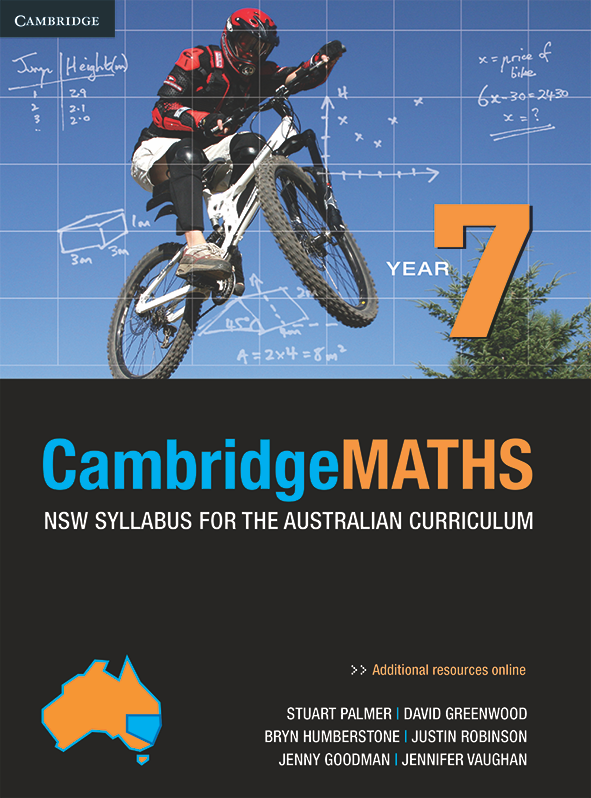CambridgeMATHS NSW Syllabus for the Australian Curriculum Year 7
To access your resources Log inor
create your Cambridge GO account
Activate your resources by entering the access code found in the front of your print textbook,
sealed pocket or supplied via email.
 PDF Textbook
PDF TextbookTo view a sample chapter, please click on the file below in blue.
Full PDF Textbook
Complete textbook [PDF 89.00Mb]
PDF Textbook chapters
Preliminary pages [PDF 2.0Mb]
Chapter 1: Computation with positive integers [PDF 4.9Mb]
Chapter 2: Angle relationships [PDF 2.0Mb]
Chapter 3: Computation with positive and negative integers [PDF 5.4Mb]
Chapter 4: Understands fractions, decimals and percentages [PDF 10.7Mb]
Chapter 5: Probability [PDF 5.8Mb]
Semester review 1 [PDF 0.7Mb]
Chapter 6: Computation with decimals and fractions [PDF 6.8Mb]
Chapter 7: Time [PDF 4.7Mb]
Chapter 8: Algebraic techniques 1 [PDF 9.6Mb]
Chapter 9: Equations 1 [PDF 7.4Mb]
Chapter 10: Measurement and computation of length, perimeter and area [PDF 11.4Mb]
Chapter 11: Introducing indices [PDF 4.4Mb]
Optional Chapter 12: Polygons and transformations [PDF 6.9Mb]
Semester review 2 [PDF 0.7Mb]
Answers [PDF 0.8Mb]
Index [PDF 0.8Mb]
You are entitled to download and store these PDFs. However they may not be transferred to another party, including other students, as electronic or print versions.
To use the enhanced PDF functions, such as note taking, you must download these PDFs to your computer and open them with Adobe Reader 9 or later.
The PDF Textbook is designed for full functionality using the latest version of Adobe Reader. The markup function is available in selected PDF readers for the iPad and other devices using iOS. Check your PDF reader specifications. At the time of publication, Adobe Reader, Good Reader and PDF Expert were viable options.
Note that some PDF file names may comprise the ISBN and chapter number.
You must have Adobe Reader installed to view the PDF files.

To view a sample chapter, please click on the file below in blue.
Full PDF Textbook
Complete textbook [PDF 89.00Mb]
PDF Textbook chapters
Preliminary pages [PDF 2.0Mb]
Chapter 1: Computation with positive integers [PDF 4.9Mb]
Chapter 2: Angle relationships [PDF 2.0Mb]
Chapter 3: Computation with positive and negative integers [PDF 5.4Mb]
Chapter 4: Understands fractions, decimals and percentages [PDF 10.7Mb]
Chapter 5: Probability [PDF 5.8Mb]
Semester review 1 [PDF 0.7Mb]
Chapter 6: Computation with decimals and fractions [PDF 6.8Mb]
Chapter 7: Time [PDF 4.7Mb]
Chapter 8: Algebraic techniques 1 [PDF 9.6Mb]
Chapter 9: Equations 1 [PDF 7.4Mb]
Chapter 10: Measurement and computation of length, perimeter and area [PDF 11.4Mb]
Chapter 11: Introducing indices [PDF 4.4Mb]
Optional Chapter 12: Polygons and transformations [PDF 6.9Mb]
Semester review 2 [PDF 0.7Mb]
Answers [PDF 0.8Mb]
Index [PDF 0.8Mb]
You are entitled to download and store these PDFs. However they may not be transferred to another party, including other students, as electronic or print versions.
To use the enhanced PDF functions, such as note taking, you must download these PDFs to your computer and open them with Adobe Reader 9 or later.
The PDF Textbook is designed for full functionality using the latest version of Adobe Reader. The markup function is available in selected PDF readers for the iPad and other devices using iOS. Check your PDF reader specifications. At the time of publication, Adobe Reader, Good Reader and PDF Expert were viable options.
Note that some PDF file names may comprise the ISBN and chapter number.
| You must have Adobe Reader installed to view the PDF files. |
 |
 Teacher Edition resources
Teacher Edition resourcesPlease note: The Teacher Resource Package does not include access to the PDF Textbook. Please use the 16-character code in the front of your textbook to access the PDF Textbook.
Log in to your teacher account and enter your 16-character code to access:
- Teacher Edition PDFs
- Chapter tests and answers
- Worksheets and answers
- Worked solutions
- Chapter summary posters
Preview pages
Chapter 1 Poster [PDF 7.2mb]
Teacher Edition Chapter 1 [PDF 23.3mb]
Chapter 1 Test [Word doc 0.1mb]
Chapter 1 Test Answers [Word doc 0.1mb]
Chapter 1 Worked Solutions [Word doc 0.1mb]
Please note: The Teacher Resource Package does not include access to the PDF Textbook. Please use the 16-character code in the front of your textbook to access the PDF Textbook.
Log in to your teacher account and enter your 16-character code to access:
- Teacher Edition PDFs
- Chapter tests and answers
- Worksheets and answers
- Worked solutions
- Chapter summary posters
Preview pages
Chapter 1 Poster [PDF 7.2mb]
Teacher Edition Chapter 1 [PDF 23.3mb]
Chapter 1 Test [Word doc 0.1mb]
Chapter 1 Test Answers [Word doc 0.1mb]
Chapter 1 Worked Solutions [Word doc 0.1mb]

